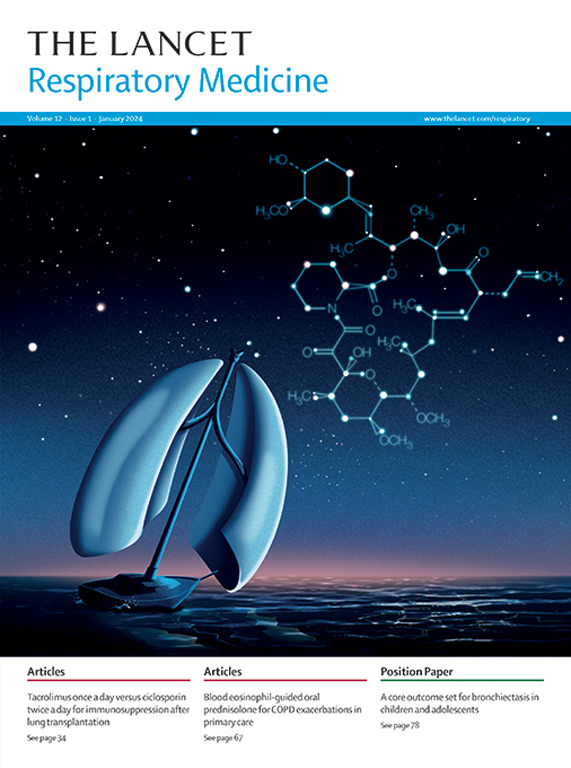Predicting benefit from adjuvant therapy with corticosteroids in community-acquired pneumonia: a data-driven analysis of randomised trials
IF 38.7
1区 医学
Q1 CRITICAL CARE MEDICINE
引用次数: 0
Abstract
Background
Despite several randomised controlled trials (RCTs) on the use of adjuvant treatment with corticosteroids in patients with community-acquired pneumonia (CAP), the effect of this intervention on mortality remains controversial. We aimed to evaluate heterogeneity of treatment effect (HTE) of adjuvant treatment with corticosteroids on 30-day mortality in patients with CAP.Methods
In this individual patient data meta-analysis, we included RCTs published before July 1, 2024, comparing adjuvant treatment with corticosteroids versus placebo in patients hospitalised with CAP. The primary endpoint was 30-day all-cause mortality, collected across all trials, and analyses followed the intention-to-treat principle. We analysed HTE using risk and effect modelling. For risk modelling, patients were classified as having less severe or severe CAP based on the pneumonia severity index (PSI), comparing PSI class I–III versus class IV–V. For effect modelling, we trained a corticosteroid-effect model on six trials and externally validated it using data from two trials, received after model preregistration. This model classified patients into two groups: no predicted benefit and predicted benefit from adjuvant treatment with corticosteroids. The literature search was registered on PROSPERO, CRD42022380746.Findings
We included eight RCTs with 3224 patients. Across all eight trials, 246 (7·6%) patients died within 30 days (106 [6·6%] of 1618 in the corticosteroid group vs 140 [8·7%] of 1606 in the placebo group; odds ratio [OR] 0·72 [95% CI 0·56–0·94], p=0·017). The corticosteroid-effect model, which selected C-reactive protein (CRP), showed significant HTE during external validation in the two most recent trials. In these trials, 154 (11·4%) of 1355 patients died within 30 days (88 [13·1%] of 671 in the placebo group vs 66 [9·6%] of 684 in the corticosteroid group; OR 0·71 [95% CI 0·50–0·99], p=0·044). Among patients predicted to have no benefit (CRP ≤204 mg/L, n=725), no significant effect was observed (OR 0·98 [95% CI 0·63–1·50]), whereas for those with predicted benefit (CRP >204 mg/L, n=630), 39 (13·0%) of 301 patients died in the placebo group compared with 20 (6·1%) of 329 in the corticosteroid group (0·43 [0·25–0·76], pinteraction=0·026). No significant HTE was found between less severe CAP (PSI class I–III, n=229) and severe CAP (PSI class IV–V, n=1126). Corticosteroid therapy significantly increased hyperglycaemia risk (44 [12·8%] of 344 in the placebo group vs 84 [24·8%] of 339 in the corticosteroid group; OR 2·50 [95% CI 1·63–3·83], p<0·0001) and hospital re-admission risk (30 [3·7%] of 814 in the placebo group vs 57 [7·0%] of 819 in the corticosteroid group; 1·95 [1·24–3·07], p=0·0038).Interpretation
Overall, adjuvant therapy with corticosteroids significantly reduces 30-day mortality in patients hospitalised with CAP. The treatment effect varied significantly among subgroups based on CRP concentrations, with a substantial mortality reduction observed only in patients with high baseline CRP.Funding
None.预测社区获得性肺炎中皮质类固醇辅助治疗的获益:一项随机试验的数据驱动分析
背景:尽管有几项随机对照试验(RCTs)研究了社区获得性肺炎(CAP)患者使用皮质类固醇辅助治疗,但这种干预对死亡率的影响仍存在争议。我们的目的是评估皮质类固醇辅助治疗对CAP患者30天死亡率的治疗效果(HTE)的异质性。方法在这项个体患者数据荟萃分析中,我们纳入了2024年7月1日之前发表的随机对照试验,比较皮质类固醇辅助治疗与安慰剂治疗CAP住院患者的30天全因死亡率。主要终点是所有试验收集的30天全因死亡率,并遵循意向治疗原则进行分析。我们使用风险和效果模型分析了HTE。在风险建模中,根据肺炎严重程度指数(PSI)将患者分为较轻或严重CAP,将PSI分为I-III级与IV-V级。对于效应建模,我们在6个试验中训练了一个皮质激素效应模型,并使用模型预注册后收到的2个试验的数据对其进行了外部验证。该模型将患者分为两组:皮质类固醇辅助治疗无预期获益和预期获益。文献检索注册号为PROSPERO, CRD42022380746。我们纳入了8项随机对照试验,共3224例患者。在所有8项试验中,246例(7.6%)患者在30天内死亡(皮质类固醇组1618例中有106例[6.6%]死亡,安慰剂组1606例中有140例[8.7%]死亡;优势比[OR] 0.72 [95% CI 0.56 ~ 0.94], p= 0.017]。在最近的两个试验中,选择c反应蛋白(CRP)的皮质类固醇效应模型在外部验证中显示出显著的HTE。在这些试验中,1355例患者中有154例(11.4%)在30天内死亡(安慰剂组671例中有88例[13.1%],皮质类固醇组684例中有66例[9.6%];OR = 0.71 [95% CI = 0.50 - 0.99], p= 0.044)。在预测无获益的患者(CRP≤204mg /L, n=725)中,未观察到显著的疗效(OR 0.98 [95% CI 0.63 - 0.50]),而在预测有获益的患者(CRP≤204mg /L, n=630)中,安慰剂组301例患者中有39例(13.0%)死亡,而皮质类固醇组329例患者中有20例(6.1%)死亡(0.43 [0.25 - 0.76],p相互作用= 0.026)。轻度CAP (PSI分类I-III, n=229)与重度CAP (PSI分类IV-V, n=1126)间未发现显著HTE。皮质类固醇治疗显著增加高血糖风险(安慰剂组344例中有44例[12.8%],而皮质类固醇组339例中有84例[24.8%];OR 2.50 [95% CI 1.63 - 3.83], p< 0.0001)和再入院风险(安慰剂组814人中有30人[3.7%],皮质类固醇组819人中有57人[7.0%];1.95 [1.24 - 3.07], p= 0.0038)。总体而言,皮质类固醇辅助治疗可显著降低CAP住院患者的30天死亡率。基于CRP浓度的亚组治疗效果差异显著,仅在基线CRP高的患者中观察到显著的死亡率降低。
本文章由计算机程序翻译,如有差异,请以英文原文为准。
求助全文
约1分钟内获得全文
求助全文
来源期刊

Lancet Respiratory Medicine
RESPIRATORY SYSTEM-RESPIRATORY SYSTEM
CiteScore
87.10
自引率
0.70%
发文量
572
期刊介绍:
The Lancet Respiratory Medicine is a renowned journal specializing in respiratory medicine and critical care. Our publication features original research that aims to advocate for change or shed light on clinical practices in the field. Additionally, we provide informative reviews on various topics related to respiratory medicine and critical care, ensuring a comprehensive coverage of the subject.
The journal covers a wide range of topics including but not limited to asthma, acute respiratory distress syndrome (ARDS), chronic obstructive pulmonary disease (COPD), tobacco control, intensive care medicine, lung cancer, cystic fibrosis, pneumonia, sarcoidosis, sepsis, mesothelioma, sleep medicine, thoracic and reconstructive surgery, tuberculosis, palliative medicine, influenza, pulmonary hypertension, pulmonary vascular disease, and respiratory infections. By encompassing such a broad spectrum of subjects, we strive to address the diverse needs and interests of our readership.
 求助内容:
求助内容: 应助结果提醒方式:
应助结果提醒方式:


